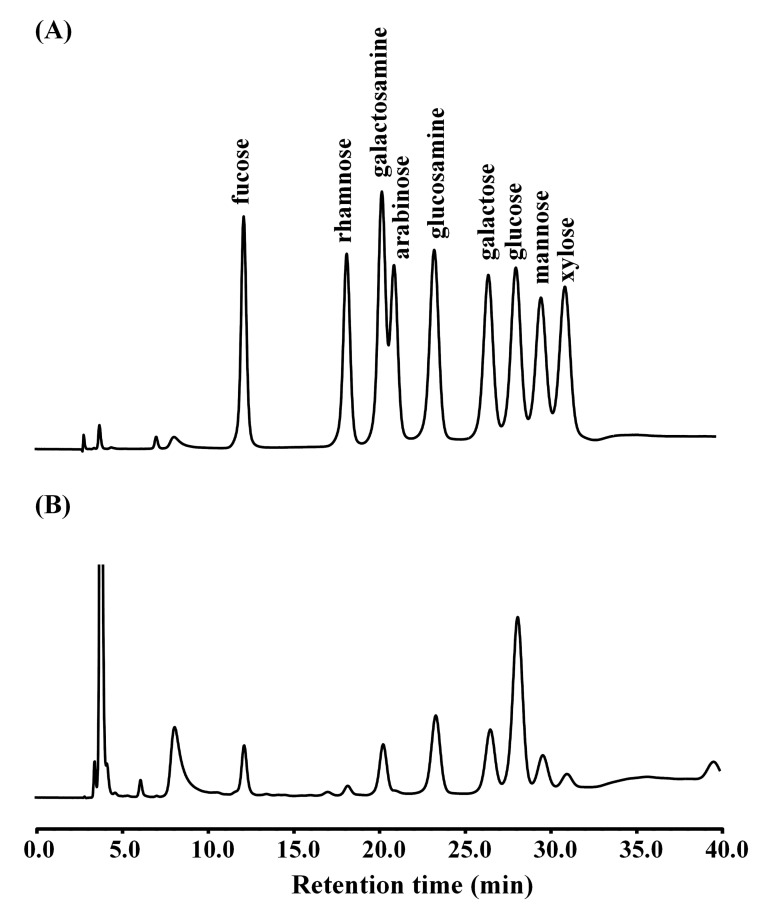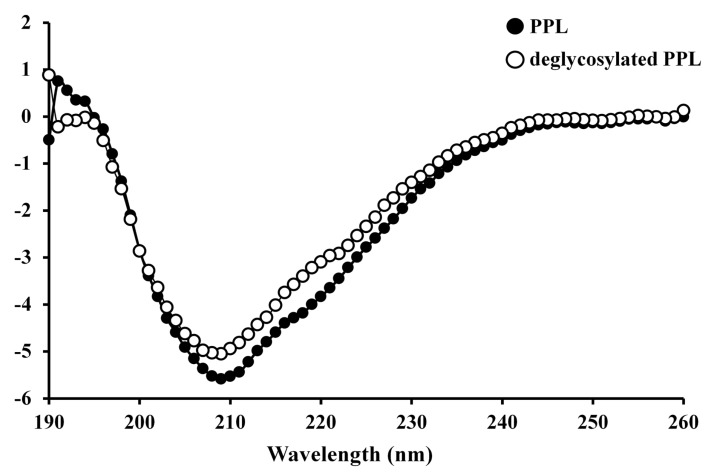Korean J Physiol Pharmacol.
2013 Dec;17(6):547-551. 10.4196/kjpp.2013.17.6.547.
Binding Specificity of Philyra pisum Lectin to Pathogen-Associated Molecular Patterns, and Its Secondary Structure
- Affiliations
-
- 1Physical Pharmacy Laboratory, College of Pharmacy, Chung-Ang University, Seoul 156-756, Korea. hahyung@cau.ac.kr
- KMID: 2285483
- DOI: http://doi.org/10.4196/kjpp.2013.17.6.547
Abstract
- We recently reported a Philyra pisum lectin (PPL) that exerts mitogenic effects on human lymphocytes, and its molecular characterization. The present study provides a more detailed characterization of PPL based on the results from a monosaccharide analysis indicating that PPL is a glycoprotein, and circular dichroism spectra revealing its estimated alpha-helix, beta-sheet, beta-turn, and random coil contents to be 14.0%, 39.6%, 15.8%, and 30.6%, respectively. These contents are quite similar to those of deglycosylated PPL, indicating that glycans do not affect its intact structure. The binding properties to different pathogen-associated molecular patterns were investigated with hemagglutination inhibition assays using lipoteichoic acid from Gram-positive bacteria, lipopolysaccharide from Gram-negative bacteria, and both mannan and beta-1,3-glucan from fungi. PPL binds to lipoteichoic acids and mannan, but not to lipopolysaccharides or beta-1,3-glucan. PPL exerted no significant antiproliferative effects against human breast or bladder cancer cells. These results indicate that PPL is a glycoprotein with a lipoteichoic acid or mannan-binding specificity and which contains low and high proportions of alpha-helix and beta-structures, respectively. These properties are inherent to the innate immune system of P. pisum and indicate that PPL could be involved in signal transmission into Gram-positive bacteria or fungi.
Keyword
MeSH Terms
-
beta-Glucans
Breast
Circular Dichroism
Fungi
Glycoproteins
Gram-Negative Bacteria
Gram-Positive Bacteria
Hemagglutination
Humans
Immune System
Lipopolysaccharides
Lymphocytes
Mannans
Polysaccharides
Sensitivity and Specificity*
Teichoic Acids
Urinary Bladder Neoplasms
Glycoproteins
Lipopolysaccharides
Mannans
Polysaccharides
Teichoic Acids
beta-Glucans
Figure
Reference
-
1. Medzhitov R, Janeway CA Jr. Innate immunity: the virtues of a nonclonal system of recognition. Cell. 1997; 91:295–298. PMID: 9363937.
Article2. Lee SY, Söderhäll K. Early events in crustacean innate immunity. Fish Shellfish Immunol. 2002; 12:421–437. PMID: 12194453.3. Medzhitov R, Janeway C Jr. Innate immune recognition: mechanisms and pathways. Immunol Rev. 2000; 173:89–97. PMID: 10719670.
Article4. Kurata S, Ariki S, Kawabata S. Recognition of pathogens and activation of immune responses in Drosophila and horseshoe crab innate immunity. Immunobiology. 2006; 211:237–249. PMID: 16697917.
Article5. Hoffmann JA, Kafatos FC, Janeway CA, Ezekowitz RA. Phylogenetic perspectives in innate immunity. Science. 1999; 284:1313–1318. PMID: 10334979.
Article6. Janeway CA Jr, Medzhitov R. Innate immune recognition. Annu Rev Immunol. 2002; 20:197–216. PMID: 11861602.
Article7. Lis H, Sharon N. Lectins as molecules and as tools. Annu Rev Biochem. 1986; 55:35–67. PMID: 3527046.
Article8. Sharon N, Lis H. Lectins-proteins with a sweet tooth: functions in cell recognition. Essays Biochem. 1995; 30:59–75. PMID: 8822149.9. Kawabata S, Iwanaga S. Role of lectins in the innate immunity of horseshoe crab. Dev Comp Immunol. 1999; 23:391–400. PMID: 10426430.
Article10. Kilpatrick DC. Animal lectins: a historical introduction and overview. Biochim Biophys Acta. 2002; 1572:187–197. PMID: 12223269.
Article11. Loris R, Hamelryck T, Bouckaert J, Wyns L. Legume lectin structure. Biochim Biophys Acta. 1998; 1383:9–36. PMID: 9546043.
Article12. Vasta GR, Ahmed H, Odom EW. Structural and functional diversity of lectin repertoires in invertebrates, protochordates and ectothermic vertebrates. Curr Opin Struct Biol. 2004; 14:617–630. PMID: 15465324.
Article13. Kim HH, Jun JI, Kim BS, Cho DH, Min TH, Kim YJ, Ryu CS. Lectin protein prepared from Korean marine crab Philyra pisum, process for preparing the same and the use thereof. US Patent. 07015313. 2006.14. Na JC, Park BT, Chung WH, Kim HH. Molecular characterization and mitogenic activity of a lectin from purse crab Philyra pisum. Korean J Physiol Pharmacol. 2011; 15:241–244. PMID: 21994481.15. Bradford MM. A rapid and sensitive method for the quantitation of microgram quantities of protein utilizing the principle of protein-dye binding. Anal Biochem. 1976; 72:248–254. PMID: 942051.
Article16. Kim BS, Oh KT, Cho DH, Kim YJ, Koo WM, Kong KH, Kim HH. A sialic acid-binding lectin from the legume Maackia fauriei: comparison with lectins from M. amurensis. Plant Sci. 2004; 167:1315–1321.17. Tominaga H, Ishiyama M, Ohseto F, Sasamoto K, Hamamoto T, Suzuki K, Watanabe M. A water-soluble tetrazolium salt useful for colorimetric cell viability assay. Anal Commun. 1999; 36:47–50.
Article18. Yang JT, Wu CS, Martinez HM. Calculation of protein conformation from circular dichroism. Methods Enzymol. 1986; 130:208–269. PMID: 3773734.19. Medzhitov R, Janeway CA Jr. Decoding the patterns of self and nonself by the innate immune system. Science. 2002; 296:298–300. PMID: 11951031.
Article20. Yu XQ, Ma Y. Calcium is not required for immulectin-2 binding, but protects the protein from proteinase digestion. Insect Biochem Mol Biol. 2006; 36:505–516. PMID: 16731346.
Article21. Polotsky VY, Fischer W, Ezekowitz RA, Joiner KA. Interactions of human mannose-binding protein with lipoteichoic acids. Infect Immun. 1996; 64:380–383. PMID: 8557371.
Article22. Ip WK, Takahashi K, Moore KJ, Stuart LM, Ezekowitz RA. Mannose-binding lectin enhances Toll-like receptors 2 and 6 signaling from the phagosome. J Exp Med. 2008; 205:169–181. PMID: 18180310.
Article23. Iwanaga S, Kawabata S. Evolution and phylogeny of defense molecules associated with innate immunity in horseshoe crab. Front Biosci. 1998; 3:D973–D984. PMID: 9727083.
Article24. Edge AS. Deglycosylation of glycoproteins with trifluoromethanesulphonic acid: elucidation of molecular structure and function. Biochem J. 2003; 376:339–350. PMID: 12974674.
Article25. Belogortseva N, Molchanova V, Glazunov V, Evtushenko E, Luk'yanov P. N-Acetyl-D-glucosamine-specific lectin from the ascidian Didemnum ternatanum. Biochim Biophys Acta. 1998; 1380:249–256. PMID: 9565695.26. Banerjee S, Chaki S, Bhowal J, Chatterjee BP. Mucin binding mitogenic lectin from freshwater Indian gastropod Belamyia bengalensis: purification and molecular characterization. Arch Biochem Biophys. 2004; 421:125–134. PMID: 14678793.27. Pereyra A, Zenteno R, Vázquez L, Martínez-Cairo S, Rodríguez A, Mendoza-Hernández G, Zenteno E, Agundis C. Characterization of lectin aggregates in the hemolymph of freshwater prawn Macrobrachium rosenbergii. Biochim Biophys Acta. 2004; 1673:122–130. PMID: 15279883.28. Alpuche J, Pereyra A, Agundis C, Rosas C, Pascual C, Slomianny MC, Vázquez L, Zenteno E. Purification and characterization of a lectin from the white shrimp Litopenaeus setiferus (Crustacea decapoda) hemolymph. Biochim Biophys Acta. 2005; 1724:86–93. PMID: 15919156.
Article29. Gowda NM, Goswami U, Khan MI. Purification and characterization of a T-antigen specific lectin from the coelomic fluid of a marine invertebrate, sea cucumber (Holothuria scabra). Fish Shellfish Immunol. 2008; 24:450–458. PMID: 18282768.30. Fabrick JA, Baker JE, Kanost MR. Innate immunity in a pyralid moth: functional evaluation of domains from a beta-1,3-glucan recognition protein. J Biol Chem. 2004; 279:26605–26611. PMID: 15084591.31. Shi WX, Shen ZM, Sun C, Yang JT. Conformation and activity of Phaseolus coccineus var. rubronanus lectin. J Protein Chem. 1993; 12:153–157. PMID: 8489702.
- Full Text Links
- Actions
-
Cited
- CITED
-
- Close
- Share
- Similar articles
-
- Molecular Characterization and Mitogenic Activity of a Lectin from Purse Crab Philyra Pisum
- Histochemical Characterization of the Lectin-binding Sites in the Equine Vomeronasal Organ
- The Role of Barrier Dysfunction and Change of Claudin Expression in Inflammatory Bowel Disease
- Lectin Histochemistry for Effects of N - Nitrosodimethylamine on Glycoconjugates in the Rat Lingual Salivary Glands
- Distribution patterns of the lectin binding in the lung tissue of perinatal rat



